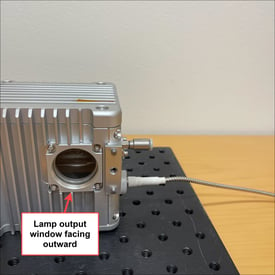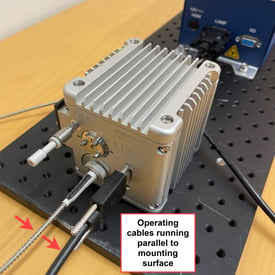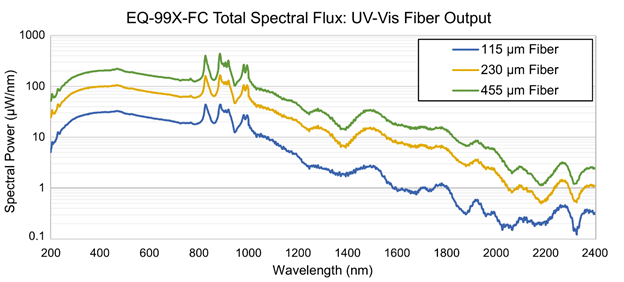Answers to Your Top LDLS® Questions
We’re here to help answer all of your Laser-Driven Light Source (LDLS®) questions. While the data below is based on typical values, we’re happy to provide more detailed specifications. Select a topic below to jump to the common questions we receive on that subject.
How do I request a quotation?
Hamamatsu Photonics distributes LDLS and LDTLS products for most countries. Please visit our contact us page or the Hamamatsu website to submit a request for a quotation or send an email to info@energetiq.com.
For information about the Electrodeless Z-Pinch™ EUV sources, please email info@energetiq.com.
Are custom configurations available?
Custom configurations are available to meet stringent OEM application requirements. Please contact us at info@energetiq.com to initiate a discussion.
What is the lifetime / output degradation of the LDLS?
We recommend changing the bulb after 10,000 hours of operation.
We define the lifetime of the lamp / bulb as when the intensity has dropped more than 50% at 500 nm. The spectral output at 500 nm decreases about 1% - 2% every 1,000 hours under standard operating conditions with nitrogen purging.
How do I initiate an RMA?
Contact your local Hamamatsu office or distributor for service requests. If you are unsure who your contact is, email us at service@energetiq.com for assistance.
What is the standard warranty for an LDLS?
Standard warranty is 12 months. Extended warranties are available for certain models and circumstances.
What is the proper mounting orientation for my LDLS lamp head?
It’s important to mount the LDLS lamp head in the proper orientation to prevent accelerated lamp bulb degradation and ensure optimal broadband light output.
If your application requires the LDLS lamp head to be mounted in an orientation other than those shown below, contact our team for suggested configurations.
Free Space Lamp Heads
When using a free-space LDLS lamp head model with a single or dual output window, ensue that the lamp head is mounted on a flat surface in an upright position with the output window(s) facing outward. Ensure that the associated operating cables are running parallel to the mounting surface as shown below.
Fiber-Coupled Lamp Heads
When using an LDLS lamp head with a fiber-coupled output, ensure that the lamp head is mounted on a flat surface in an upright position with the fiber-coupled output port facing upward. Ensure that the associated operating cables are running parallel to the mounting surface as shown below.
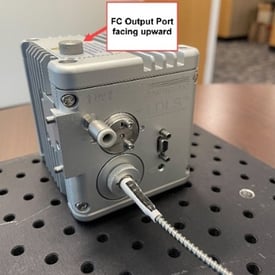
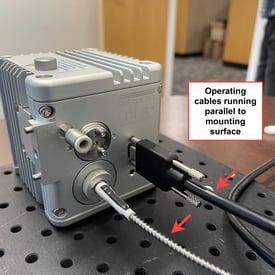
What is the warm-up time of the LDLS?
We recommend a warm-up time of approximately 30 minutes before taking measurements to ensure that the LDLS system has reached thermal equilibrium. The actual warm-up time for an application may be longer or shorter depending on the precision of measurements to be made.
Do LDLS systems require external cooling?
The EQ-99X and EQ-99X-FC do not require auxiliary cooling. The EQ-77X and EQ-400 both require water cooling.
Read our Technical Note for a full explanation of the cooling requirements for the EQ-400.
EQ-77X
- Lamp Head: 0.5 liter/minute, 18 - 30°C, 100 psig (0.69 MPa) max. inlet pressure
EQ-400
- Lamp Head: ≥ 1 liter/minute, 18 - 30°C
- Controller: 3 - 4 liters/minute, 18 - 24°C
What is the spectral range of LDLS?
EQ-99X, EQ-9, EQ-77X, and EQ-400 have a spectral range of 170 nm to 2500 nm. The EQ-99X-FC has a spectral range of 190 nm to 2500 nm.
What are the options for the output window material of the LDLS? What window type is right for my application?
EQ-99X, EQ-9, EQ-77X, and EQ-400 have a spectral range of 170 nm to 2500 nm.
Window selection is typically influenced by the effect of ultraviolet light on your application. The standard configuration for all LDLS models is with a quartz (QZ) output window. For applications that suffer from UV exposure, YAG and BK7 windows offer the benefit of filtering out energy from 170 nm to 190 nm and 170 nm to 350 nm, respectively. MgF windows are ideal for applications that benefit from enhanced deep-UV radiance from 170 nm to 200 nm.
What is the radiance performance of the free space LDLS?
LDLS Model | Typical Radiance at 500 nm
- EQ-99X — 25 mW/mm2.sr.nm
- EQ-9 — 20 mW/mm2.sr.nm
- EQ-77X — 75 mW/mm2.sr.nm
- EQ-400 — 110 mW/mm2.sr.nm
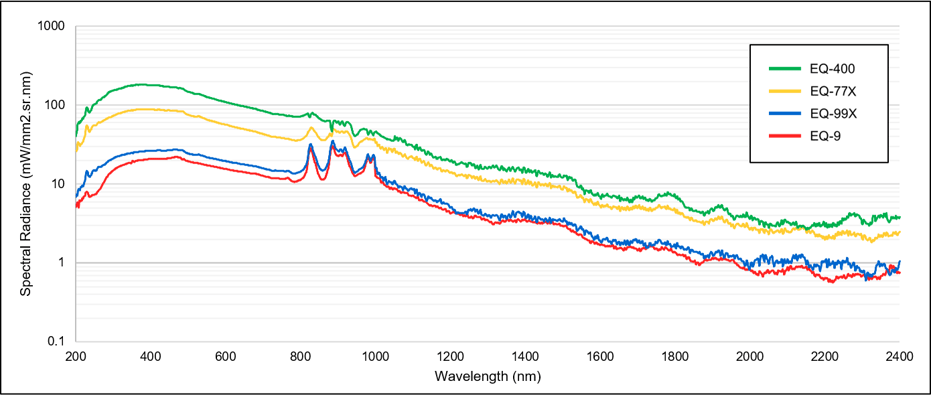
What is the Numerical Aperture (NA) of each of the LDLS?
LDLS Model | Numerical Aperature
- EQ-99X — 0.47
- EQ-9 — 0.56
- EQ-77X — 0.5
- EQ-400 — 0.4
- EQ-99X-FC (with fiber output)— 0.22
What is the total broadband optical power of the LDLS?
LDLS Model | Broadband Optical Power*
- EQ-99X — 0.75 W
- EQ-9 — 0.5 W
- EQ-77X — 2.75 W
- EQ-400 — 15 W
- EQ-99X-FC — 95 mW**
*Measured with thermophile
**UVFIBERX-230 fiber optic cable
Are collection optics available for free-space LDLS models?
We offer off-axis parabolic mirror (OAP) assemblies that can be used with the EQ-99X and EQ-77X models that collect, collimate, and focus the spectral output.
The table below shares additional information:
4" EFL OAP
- Effective Focal Length (EFL) — 4.0"
- Diameter — 1.5"
- Magnification — 2X
- Numerical Aperture (NA) — 0.188
- F/# — 2.67
6" EFL OAP
- Effective Focal Length (EFL) — 6.0"
- Diameter — 1.5"
- Magnification — 3X
- Numerical Aperture (NA) — 0.125
- F/# — 4.0
8" EFL OAP
- Effective Focal Length (EFL) — 8.0"
- Diameter — 1.5"
- Magnification — 4X
- Numerical Aperture (NA) — 0.094
- F/# — 5.33
How far is the center of the plasma from the output window of the free space LDLS?
Average distance of plasma from output window (using quartz output window):
LDLS Model | Distance
- EQ-99X — 20.1 mm
- EQ-9 — 15 mm
- EQ-77X — 13.7 mm
- EQ-400 — 19 mm
Is it possible to purchase an LDLS with a dual output?
The EQ-9, EQ-77X, and EQ-400 can be purchased without a retroreflector, allowing for a dual output configuration. Please email us at info@energetiq.com to connect with an Applications Engineer who can help you determine if this configuration suits your application.
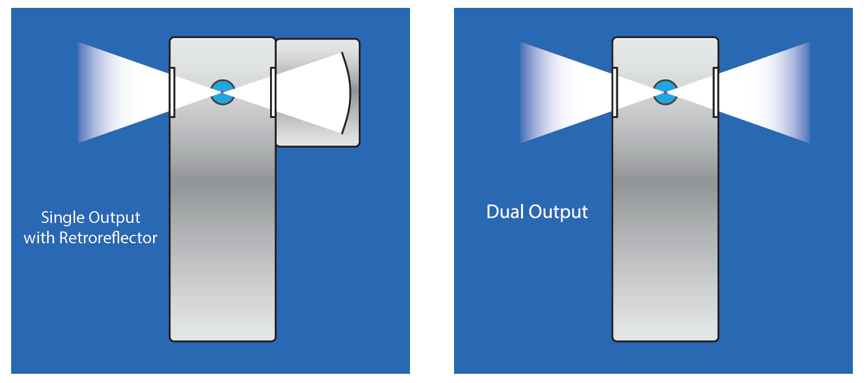
What is the spatial stability of the plasma of the LDLS?
The position of the plasma is very precisely positioned in space at the focal point of the laser that sustains it. The standard deviation of the plasma light intensity “center of mass” position is less than 0.5μm in the x or y position.
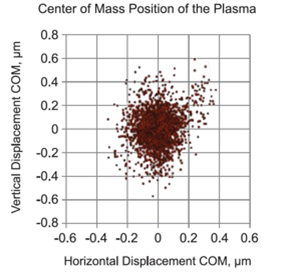
What is the average plasma size of the LDLS?
LDLS Model | Average Plasma Size
- EQ-99X —100 μm x 180 μm
- EQ-9 —85 μm x 200 μm
- EQ-77X —125 μm x 320 μm
- EQ-400 —370 μm x 800 μm
Is there a fiber coupled version of the LDLS?
Yes, the EQ-99X-FC is a fiber coupled version of the EQ-99X free space LDLS. Energetiq sells two types of fibers for use with the EQ-99X-FC LDLS. They are UV-Vis Solarization Resistant (UV) and Broadband (BB).
What is the difference between UV-Vis Solarization Resistant (UV) and Broadband (BB) fibers?
Both the UV-Vis and Broadband fibers transmit from 190 nm to 2500 nm. However, the UV-Vis fibers are constructed using high OH material and are engineered to withstand ultraviolet solarization. They provide higher output from 190 nm to 900 nm when compared to Broadband fibers of comparable core size.

The UV fibers are ideal for applications benefiting from enhanced radiance from 190 nm – 350 nm and the BB fibers are preferable for applications that benefit from enhanced radiance from 350 nm to 2500 nm.
What is the fiber output termination?
All fibers connect to the lamphead via FC connection and are available with either SMA or FC output termination. The user can select the termination for the output end of the fiber according to their application requirements.
How do I select the correct fiber for my application?
First you must select either the UV-Vis or Broadband fiber type as described above. For each fiber type there are multiple core size options. Every fiber is available at 1 or 2 meter of length and are available with either SMA or FC output termination. Reference the Fiber Optic Cable Assemblies data sheet for additional information.
For instance, the UVFIBERX-115-1M-FC-SMA is a UV-Vis fiber with a 115 μm core size, 1 meter length and SMA output termination.
What is the total output power performance of the available fibers?
Below shows the average total power output for each fiber as measured with a thermopile. For detailed power data, refer to the graphs below:
Type: UV
- Core Size: 115 μm
- Length: 1 meter
- Total Broadband Optical Power: 30 mW
Type: UV
- Core Size: 230 μm
- Length: 1 meter
- Total Broadband Optical Power: 95 mW
Type: UV
- Core Size: 455 μm
- Length: 1 meter
- Total Broadband Optical Power: 195 mW
Type: BB
- Core Size: 100 μm
- Length: 1 meter
- Total Broadband Optical Power: 25 mW
Type: BB
- Core Size: 200 μm
- Length: 1 meter
- Total Broadband Optical Power: 80 mW
Type: BB
- Core Size: 400 μm
- Length: 1 meter
- Total Broadband Optical Power: 180 mW
Type: BB
- Core Size: 600 μm
- Length: 1 meter
- Total Broadband Optical Power: 215 mW
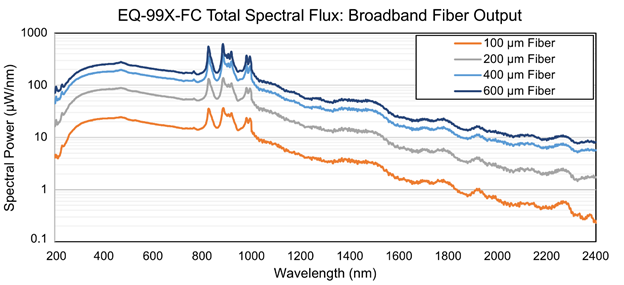
What should I use to collimate the EQ-99X-FC?
There are four collimator assembly models available to purchase from Energetiq for use with the EQ-99X-FC. You should select the collimator based on your area of illumination and the output termination of the fiber optic cable assembly you plan to use.
Part Number | Beam Diameter | Fiber Connection
- EQ-99-COL-6-SMA — 6.6 mm | SMA
- EQ-99-COL-6-FC — 6.6 mm | FC
- EQ-99-COL-11-SMA — 11 mm | SMA
- EQ-99-COL-11-FC — 11 mm | FC
Is it possible to use non-Energetiq fibers to couple the EQ-99X-FC LDLS?
Our proprietary fibers must be used with the EQ-99X-FC. Using off-the-shelf, commercially available fibers can cause damage to the lamp head and are not approved for use with the LDLS.
What is the numerical aperture of the fibers? Is the fiber PC or APC? Is the fiber narrow key or wide key?
All EQ-99X-FC fibers have a numerical aperture (NA) of 0.22, and are PC type with narrow key.
Is there a limit on the output fiber length from the lamp head to the application?
For both the UV resistance and broadband fibers, EQ offers one- and two-meter-long fibers. Since even the best optical fibers absorb light in the deep UV, it is recommended to use the shortest fiber length possible to maximize the potential of the LDLS.
For the EQ-99X and EQ-99X-FC, what are the restrictions on the laser fiber between the lamp head and the power supply?
The standard configuration of the EQ-99X and EQ-99X-FC has one-meter-long laser fiber between the lamp head and power supply.
When do I need to purge the LDLS?
For the EQ-99X, EQ-99X-FC, EQ-9, and EQ-77X systems, it is recommended to purge the LDLS with dry nitrogen while operating. For the EQ-400 system, it is required to nitrogen purge.
LDLS products emit significant amounts of deep UV light. Light below 200 nm produces ozone in the presence of oxygen, and the ozone produced has an absorption band in the 220 nm to 280 nm range. To use light from the LDLS in the 170 to 280 nm range, the system should be purged with high purity nitrogen. Purging with high purity nitrogen also reduces the possibility of photo-contamination of the bulb from trace organic vapors present in room air.
What grade of nitrogen is recommended to use in the purging process?
For nitrogen purge, a grade of 4.8 or higher purity is recommended to maintain the optics’ cleanliness.
What pressure is required for the dry nitrogen purge?
The inlet pressure of nitrogen supply should be set at 20psig (0.14 MPa) for all LDLS models. At the 20 psig, the N2 consumption rate is typically at 0.4 liters/min.
The EQ-99X, EQ-99X-FC, EQ-77X, and EQ-400 models have gas restrictor(s) installed. Their users can also control nitrogen flow rate using a gas flow regulator. The nitrogen flow rate guidance is 0.4 liters/min +/- 0.1 for the lamp head. (For LDLS models with a retroreflector installed, there may be additional nitrogen flow guidance for the retroreflector. Please see user guides for individual LDLS models and/or laser marking on the retroreflector).
On the EQ-99X lamp head, there is no outlet fitting for the purging nitrogen. The nitrogen purge gas leaks out of the lamp head enclosure through the non-hermetic gaps to the atmosphere. For LDLS models EQ-77X and EQ-400, the lamp head includes a nitrogen purge gas inlet and outlet. For more details, please see user guides for individual LDLS models.
Can you purge with other gases besides nitrogen?
No. Only high purity nitrogen can be used to purge the LDLS systems.
Can you put a vacuum on the lamp head instead of purging with nitrogen?
No. The LDLS systems will not hold a vacuum and connecting to a vacuum may cause damage to the optics.
Can I use the LDLS in a cleanroom environment?
It is not required. However, the standard operating environment for LDLS is in a cleanroom with nitrogen purging. The EQ-9, EQ-77X and EQ-400 have additional cooling requirements.
Are LDLS laser products?
No. During all normal operation of LDLS there is no laser output. Our products create incoherent broadband radiation. In a contained system, a laser is used to sustain a xenon plasma and the radiation exiting the LDLS is from the plasma.
What Laser Class are LDLS products?
LDLS Model | Laser Class
- EQ-99X — Class 1 (IEC 60825-1: 2014)
- EQ-9 — Class 1 (IEC 60825-1: 2014)
- EQ-77X — Class 1 (IEC 60825-1: 2014)
- EQ-400 — Class 4 (IEC 60825-1: 2014)
- EQ-99X-FC — Class 1 (IEC 60825-1: 2014)


